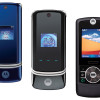Preview: MOTOKRZR K1m
The Contact manager has undergone a complete redesign. It is now similar to that of Sony Ericsson, using tabs to separate data types. The first tab has space for a name and up to 5 phone numbers. The second tab allows you to customize a photo and ringtone for Caller ID and the final tab has space for an email address, web address, contact group and even a custom memo. All of the applications now allow you to enter text directly in a field without having to press select first, which is a nice improvement.
Messaging is different than any Sprint phone we've seen. The entire message addressing and composition process takes place on one screen, similar to the Verizon messaging interface. Like other Motorola phones, the K1m uses iTAP predictive text, but the Sprint version looks and acts more like T9 than the version on GSM handsets.
The camera and pictures applications are new too. Even though there is a new camera application in the GSM RIZR and KRZR, this is yet another new version. And this is the one application that we're not sure is an improvement over the new Motorola default. The K1m features a full screen viewfinder, which like many other clamshell phones uses a vertical screen to frame a horizontal picture. Thus you will not be able to see your full picture until the review screen. (Unfortunately the camera was not working on our prototype, so we cannot show you this as well as we'd like.)
The camera options are shown in a cascading menu instead of the transparent overlay of the new GSM models. We'd prefer the overlay since it gives you a live preview of every option. The only options with a live preview on the K1m are digital zoom (up to 4x) and brightness. For all other options you must choose one and then check that it does what you wanted.
Once a picture is snapped it is automatically saved. You can choose to save pictures to a mysterious place called "in camera" or to the memory card. While saving the picture you just took, the review screen gives you the option to delete or send it.
When viewing pictures, you have the option to see pictures from the memory card, the camera, or ones that have been saved to the phone. As with other Sprint phones, you cannot simply go to the gallery application and see all your pictures if they are stored in different places. The gallery does not have an option to zoom in on a photo, nor does it include any new options when compared to previous Sprint handsets. Sending a photo via Bluetooth is still not permitted.
Videos are limited to 30 seconds in length and can be shot using the digital zoom, though you cannot zoom while recording.
The rest of the applications we were able to preview are similar to those in current Motorola phones, only they've been given a facelift to match everything else on the phone.
Overall, the changes to the software seem like an improvement over current offerings from both Sprint and Motorola. In fact, we wish some of these changes were available on GSM KRZRs. However, Motorola would prefer to release their new Linux-Java software on GSM handsets, and that too is highly improved over the old Moto software we see on RAZRs and their ilk.
Our only software complaint with Sprint's K1m is that you still need two separate applications to play music depending on whether you used Sprint's software or just a PC and card reader to load music on your phone.
Although we were not able to evaluate the K1m on reception, battery life and other performance issues, if those match Motorola's other recent models, this should prove to be a solid phone for Sprint this holiday season.

























 MOTO2006
MOTO2006
 New Motorola Phones Get A Human Touch
New Motorola Phones Get A Human Touch
 Hands On with the Motorola edge+ (2022)
Hands On with the Motorola edge+ (2022)
 Hands On with the Motorola moto g stylus 5G (2022)
Hands On with the Motorola moto g stylus 5G (2022)
 Hands on with the moto g 5G
Hands on with the moto g 5G
 Motorola KRZR K1m
Motorola KRZR K1m

